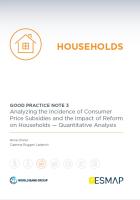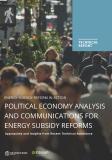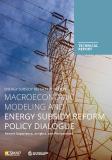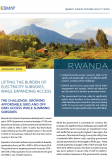Publications
This note aims to provide guidance on how to assess the distributional implications of energy subsidy reform (ESR) using quantitative methods. It is intended for use by those familiar with the basics of welfare measurement, ideally part of a multi-disciplinary team. Ideally this assessment would therefore be complemented by insights from qualitative analysis and by an analysis of the effectiveness of feasible compensatory measures. The note focuses on how to assess the distributional implications of household level impacts of ESR (as opposed to firm level, discussed in Good Practice Note 6). Its scope is confined to cases where ESRs lead to higher prices paid by energy consumers. As Good Practice Note 1 outlines, ESRs do not necessarily lead to higher prices, and could even decrease prices actually paid, such as when producer subsidies in the form of price support paid for by consumers are eliminated, or when consumer price subsidies lead to illegal diversion and out-smuggling, acute fuel shortages, and prices that are even higher than official prices on the black markets. The latter is particularly important, because a lack of data often forces the distributional analysis of ESRs to take observed expenditures on subsidized energy and scale them in proportion to the calculated price gaps—the gap between the unsubsidized price and the official price—to estimate the incidence of subsidies, whereas in practice consumers may be paying much higher prices than the official prices.
Further, this note is not confined only to ESRs in that the distributional effects of higher prices of fuels used as feed stocks—such as natural gas used in fertilizer manufacturer—are also captured. In addition, while this note tries to present a general approach, practical pointers are provided that are relevant for the analysis of different types of energy, the prices of which are rising, and which are used either directly or in the production of goods and services widely in the economy. Overall, therefore, the note discusses the analysis of liquid fuels, gas, electricity and district heating (a source of heating used primarily in Eastern Europe). The word prices applies to all forms of energy, while tariffs applies to schedules of regulated prices that are applicable to regulated electricity, gas, or district heating. For households—the focus of this paper—two main channels of impacts can be identified, relating respectively to consumption patterns and income streams. goth consumption and income can be affected directly by higher prices for energy, or indirectly through other price changes triggered by the changes in energy prices (most notably through higher transport costs caused by rises in gasoline and diesel prices). These indirect effects, though harder to quantify than direct effects, can be significant for petroleum products.
ESRAF Good Practice Overview: Guidance for Comprehensive Energy Subsidy Reforms
ESRAF Good Practice Note 1: Identifying and Quantifying Energy Subsidies
ESRAF Good Practice Note 2: Assessing the Fiscal Cost of Subsidies and Fiscal Impact of Reform
ESRAF Good Practice Note 6 to come: Identifying the Impacts of Higher Energy Prices on Firms and Industrial Competitiveness
ESRAF Good Practice Note 7: Modeling Macroeconomic Impacts and Global Externalities
ESRAF Good Practice Note 10: Designing Communication Campaigns for Energy Subsidy Reform
Olivier, Anne; Ruggeri Laderchi, Caterina. 2018. Analyzing the Incidence of Consumer Price Subsidies and the Impact of Reform on Households — Quantitative Analysis: Energy Subsidy Reform Assessment Framework (ESRAF) Good Practice Note 3. ESMAP Paper. Washington, D.C.: World Bank Group. http://documents.worldbank.org/curated/en/250011530882467380/pdf/ESRAF-note-3-Analyzing-the-Incidence-of-Consumer-Price-Subsidies-and-the-Impact-of-Reform-on-Households-Quantitative.pdf




